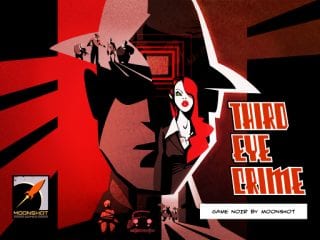
Last week I sat down with Damian Isla, Co-Founder and President of Moonshot Games, to check out their newest project, Third Eye Crime. This top-down, stealth/puzzle game is a striking departure from the company’s previous project, the side-scrolling co-op shooter Fallen Frontier. To avoid the publishing problems that regrettably led to Fallen Frontier’s eventual cancellation, Moonshot is completely footing the bill this time around.
“For some ways it makes development a lot faster,” says Damian. “Anytime that you’re looking for funding and a publisher, that takes a lot of time. The nice thing about publishing on your own is you don’t have to do that process, you just make the game.”
Third Eye Crime puts players in the role of Rothko, a telepathic art thief, whose pilfering powers of the paranormal get him involved in a tale of danger, deception, and dames, wonderfully illustrated by the game’s unique art style. “I’ve always been crazy about noire,” says Damian. “I feel that it’s underrepresented in games.” While Third Eye Crime’s color palette brazenly extends beyond that of typical noire, its colorfulness actually works to intensify the game’s tone. This moody atmosphere is most apparent when the game’s sultry, mournful jazz soundtrack plays over the slick, graphic novel-esque narrations between chapters.

I wasn’t long into my demo before it became apparent that Third Eye Crime deviates heavily from most stealth titles. While most focus on remaining undetected, Third Eye Crime actually requires players to be seen. When spotted by a guard, red areas appear to indicate where the guards thought I was hiding. Unlike regular stealth game enemies that mechanically return to their post or resume their patrols after losing sight of the protagonist, the attention spans of the guards in this game are far more realistic.
The AI in Third Eye Crime is unique in that it is unscripted, allowing guards to continually search while making educated decisions regarding the player’s ever-changing hiding spot. “The game is ultimately about tricking AI,” explains Damian. “It’s about being seen and then tricking them into doing the wrong things and exploiting their mistakes. Most stealth games are played before you are sighted. Our game is played between the time you are sighted and the end of each level. The interesting part of our game is the chase and the evasion, rather than the initial approach.”
The early levels, which serve as a tutorial, did feel almost unnecessary as the game’s familiar “line-draw” control scheme is quite basic and easy to understand. Things grew more complicated, however, as I encountered new enemy variations, such as the fleet-footed guard and armed guard, and new environmental hazards, such as security alarms and water-covered rooms.
Third Eye Crime is unlike anything currently available for mobile devices in style and gameplay. Its ambitious AI and refusal to conform to genre expectations, both noire and stealth, give Third Eye Crime the potential to garner a lot of attention when it sneaks into the App Store this spring. To check it out for yourself, stop by the Indie Showcase at PAX East this year to get an exclusive look at the first three levels.


RT @BlastMagazine: Third Eye Crime Preview: A new kind of stealth: Blast Exclusive Hands-on Preview!
I sat down with @damian_isla from @moonshotgames for a hands-on preview of their newest project. Check it out!
http://t.co/hTAb7pFUjc
“Third Eye Crime: A New Kind of Stealth” preview w/ @Catwo0d from Blast Magazine! http://t.co/L3xxHSWHDF
RT @moonshotgames: “Third Eye Crime: A New Kind of Stealth” preview w/ @Catwo0d from Blast Magazine! http://t.co/L3xxHSWHDF
Info. on #ThirdEyeCrime slowly starting to come out.. http://t.co/MwWt1RjWyt
RT @moonshotgames: “Third Eye Crime: A New Kind of Stealth” preview w/ @Catwo0d from Blast Magazine! http://t.co/L3xxHSWHDF